The efficient packaging of Venezuelan equine encephalitis virus-specific RNAs into viral particles is determined by nsP1-3 synthesis
- PMID: 16239019
- PMCID: PMC2430184
- DOI: 10.1016/j.virol.2005.09.010
The efficient packaging of Venezuelan equine encephalitis virus-specific RNAs into viral particles is determined by nsP1-3 synthesis
Abstract
Alphaviruses are regarded as attractive systems for expression of heterologous genes and development of recombinant vaccines. Venezuelan equine encephalitis virus (VEE)-based vectors are particularly promising because of their specificity to lymphoid tissues and strong resistance to interferon. To improve understanding of the VEE genome packaging and optimize application of this virus as a vector, we analyzed in more detail the mechanism of packaging of the VEE-specific RNAs. The presence of the RNAs in the VEE particles during serial passaging in tissue culture was found to depend not only on the presence of packaging signal(s), but also on the ability of these RNAs to express in cis nsP1, nsP2 and nsP3 in the form of a P123 precursor. Packaging of VEE genomes into infectious virions was also found to be more efficient compared to that of Sindbis virus, in spite of lower levels of RNA replication and structural protein production.
Figures
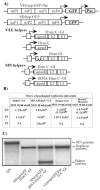

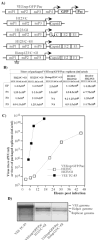
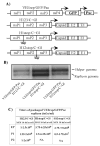
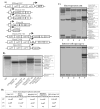
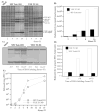
Similar articles
-
Replicon-helper systems from attenuated Venezuelan equine encephalitis virus: expression of heterologous genes in vitro and immunization against heterologous pathogens in vivo.Virology. 1997 Dec 22;239(2):389-401. doi: 10.1006/viro.1997.8878. Virology. 1997. PMID: 9434729
-
Conservation of a packaging signal and the viral genome RNA packaging mechanism in alphavirus evolution.J Virol. 2011 Aug;85(16):8022-36. doi: 10.1128/JVI.00644-11. Epub 2011 Jun 15. J Virol. 2011. PMID: 21680508 Free PMC article.
-
Noncytopathic replication of Venezuelan equine encephalitis virus and eastern equine encephalitis virus replicons in Mammalian cells.J Virol. 2005 Jun;79(12):7597-608. doi: 10.1128/JVI.79.12.7597-7608.2005. J Virol. 2005. PMID: 15919912 Free PMC article.
-
Heterologous gene expression from transmissible gastroenteritis virus replicon particles.J Virol. 2002 Feb;76(3):1422-34. doi: 10.1128/jvi.76.3.1422-1434.2002. J Virol. 2002. PMID: 11773416 Free PMC article.
-
Venezuelan Equine Encephalitis Virus Capsid-The Clever Caper.Viruses. 2017 Sep 29;9(10):279. doi: 10.3390/v9100279. Viruses. 2017. PMID: 28961161 Free PMC article. Review.
Cited by
-
Enhancement of protein expression by alphavirus replicons by designing self-replicating subgenomic RNAs.Proc Natl Acad Sci U S A. 2014 Jul 22;111(29):10708-13. doi: 10.1073/pnas.1408677111. Epub 2014 Jul 7. Proc Natl Acad Sci U S A. 2014. PMID: 25002490 Free PMC article.
-
Production and characterization of vaccines based on flaviviruses defective in replication.Virology. 2006 Aug 1;351(2):432-43. doi: 10.1016/j.virol.2006.04.003. Epub 2006 May 18. Virology. 2006. PMID: 16712897 Free PMC article.
-
A physical interaction between viral replicase and capsid protein is required for genome-packaging specificity in an RNA virus.J Virol. 2012 Jun;86(11):6210-21. doi: 10.1128/JVI.07184-11. Epub 2012 Mar 21. J Virol. 2012. PMID: 22438552 Free PMC article.
-
Infectious DNAs derived from insect-specific flavivirus genomes enable identification of pre- and post-entry host restrictions in vertebrate cells.Sci Rep. 2017 Jun 7;7(1):2940. doi: 10.1038/s41598-017-03120-1. Sci Rep. 2017. PMID: 28592864 Free PMC article.
-
Evasion of the innate immune response: the Old World alphavirus nsP2 protein induces rapid degradation of Rpb1, a catalytic subunit of RNA polymerase II.J Virol. 2012 Jul;86(13):7180-91. doi: 10.1128/JVI.00541-12. Epub 2012 Apr 18. J Virol. 2012. PMID: 22514352 Free PMC article.
References
Publication types
MeSH terms
Substances
Grants and funding
LinkOut - more resources
Full Text Sources
Other Literature Sources

